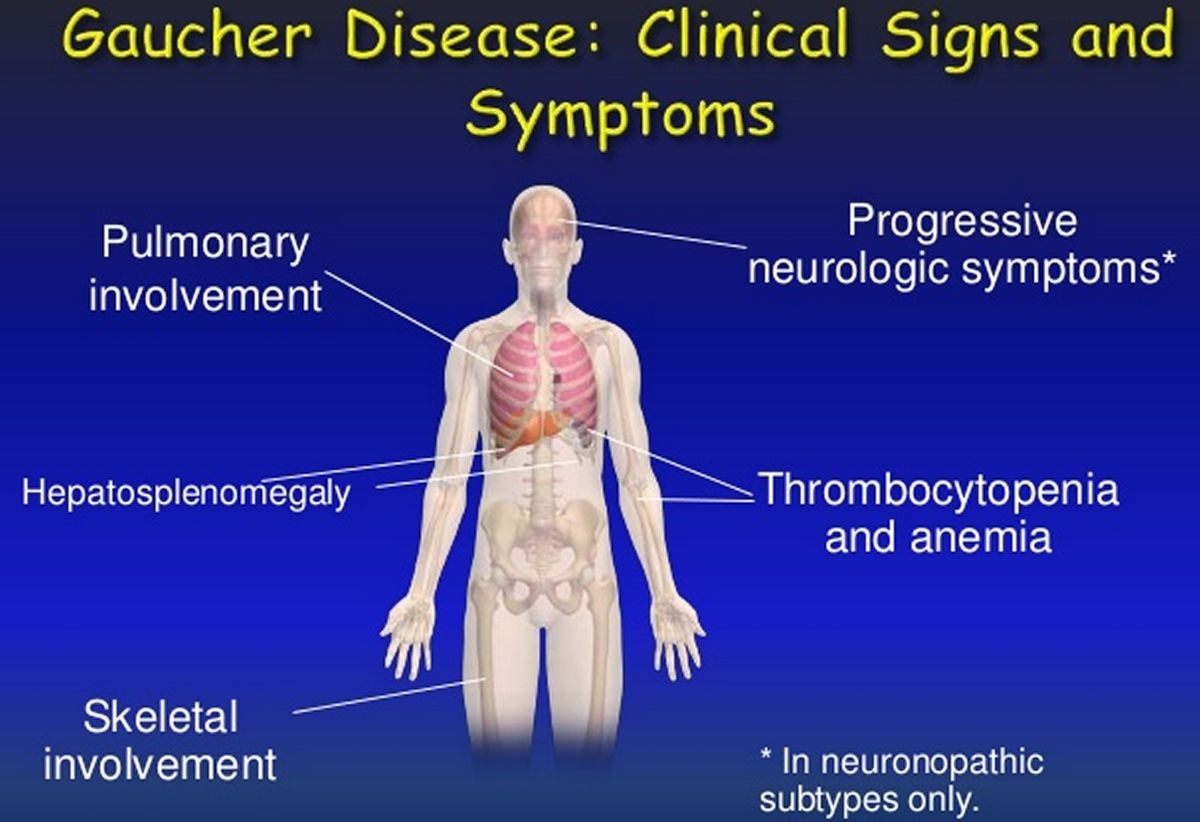
Contents
Gaucher Disease
Gaucher disease is an inherited condition that causes the abnormal accumulation of glycolipids in body tissues due to a deficiency of the enzyme glucocerebrosidase. There are different types of the condition, and the signs and symptoms vary. Gaucher disease is caused by a genetic defect in the GBA1 gene and belongs to a class of diseases called lysosomal storage diseases.
Signs and Symptoms
Main signs and symptoms of Gaucher disease include:
- Anemia
- Fatigue
- Low platelet count leading to easy bruising
- Enlarged spleen and liver
- Lung problems
- Eye movement disorders
- Yellow spots in the eyes
- Difficult-to-stop bleeding
- Bone pain and fractures
People with type 1 Gaucher disease typically first notice painless enlargement of the spleen, anemia, or bleeding due to low platelet count. Skeletal involvement is common, leading to bone pain and fractures.
Inheritance and Prevalence
Gaucher disease is inherited in an autosomal recessive pattern, and it is more common in people of Ashkenazi Jewish descent. In the non-Jewish population, it affects 1 out of every 40,000 people.
Types of Gaucher Disease
Type 1 Gaucher Disease
The most common form of Gaucher disease is type 1, which can vary in severity. It typically does not affect the central nervous system.
Type 2 Gaucher Disease
This rare type affects the nervous system and can result in seizures, eye movement problems, and brain damage. It is life-threatening and appears in infancy.
Type 3 Gaucher Disease
Similar to type 2, type 3 is a chronic form that affects the nervous system. Symptoms may appear in infancy or later in childhood.
Perinatal Lethal Gaucher Disease
This is the most severe form of Gaucher disease, with life-threatening conditions appearing before birth and survival for only a few days after birth.
Cardiovascular Gaucher Disease
This rare subtype primarily affects the heart, leading to heart valve calcification.
Cause and Diagnosis
All types of Gaucher disease are caused by a deficiency of the enzyme glucocerebrosidase, resulting in the buildup of glycolipids in cells. Genetic analysis can establish the specific gene mutations.
Treatment and Prognosis
There is no cure for Gaucher disease, but enzyme replacement therapy is the primary treatment. Other medications that block the production of accumulating substances can also be used. Life expectancy is good with treatment, and many patients have few symptoms and reach a normal lifespan.
Support and Resources
Living with Gaucher disease can be challenging, but support is available through organizations like the National Gaucher Foundation.
Also Known As
Gaucher disease is also referred to by various other names in medical literature.
Subscribe to MedicineNet’s Children’s Health & Parenting Newsletter
By clicking "Submit," I agree to the MedicineNet Terms and Conditions and Privacy Policy. I also agree to receive emails from MedicineNet and I understand that I may opt out of MedicineNet subscriptions at any time.
Medically reviewed by John A. Seibel, MD; Board Certified Internal Medicine with a subspecialty in Endocrinology & Metabolism
United States. National Library of Medicine; Genetics Home Reference. "Gaucher disease." Aug. 17, 2020. .
United States. National Library of Medicine; Genetics Home Reference. "Gaucher disease." Aug. 17, 2020. .


